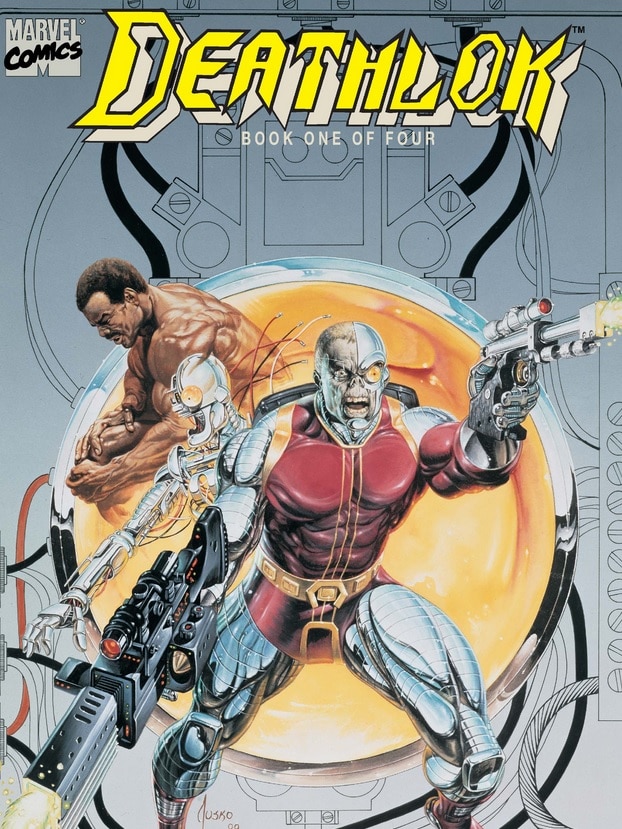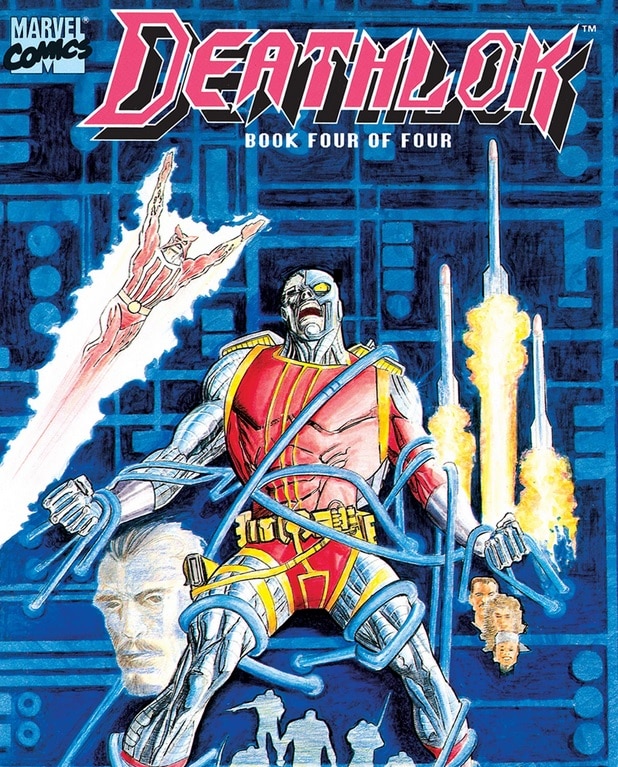Welcome to the latest edition of My 90s Life, where I read and review comic books from the 1990s. Sometimes, the comics are good. Sometimes, the comics are bad. Sometimes, the comics surprise me. This month’s comic is more of the latter.
Today, I am going to tackle the superb Deathlok prestige format miniseries from 1990 by attempting to answer the question, “How in the world is this book not considered to be a Marvel classic?”
Rediscovering the Deathlok Miniseries
My deep dive into 90s comics over the last year has led me to pick up many of the books that I fondly remember from the time period. Back in middle and high school, none of my friends and I had the supplies to buy everything Marvel produced individually.
However, the collective purchasing power and diversity in tastes of the dozen-plus nerds in our school gave all of us the rich opportunity to read virtually everything Marvel produced in the 90s. We had a flourishing trade community/economy, and fortunately for us, most of the dweebs involved were confirmed Marvel Zombies. It was within this ecosystem that I was first introduced to Deathlok.

Having traded so heavily during the time meant most of these books were traded away or read on loan in the first place. I have spent much time the last few years filling in the holes of my comic book collection based on the memory of the books I read from my friends back then.
Michael Collins, the star of the miniseries and ongoing series of the 1990s, is my Deathlok. He’s not the original, but he’s the Deathlok most fans have read. Having finally completed my Deathlok volume 2 collection recently, I decided to revisit the original miniseries featuring Collins.
Unlike my tongue in cheek appreciation for Darkhawk (who, let’s face it, is kind of trash), I legitimately love Deathlok. Though I missed out on the original miniseries, I was a big fan of the main series from the early 90s that followed the Michael Collins character. Those first five or six issues of Deathlok were some of my most beloved books from the 90s that didn’t start with the letter X.
I was eventually able to pick up the original miniseries sometime in the mid-90s out of the quarter bin of a local shop (remember those bins!). Over the years, it’s been a go-to recommendation from me for criminally overlooked Marvel series along with Strikeforce: Morituri, Untold Tales of Spider-Man, and Punisher: Return to Big Nothing.
And now I get to recommend the book to you. Onwards!
Getting a Lock on Deathlok
Just who is Deathlok? It might be easy for the uninitiated to liken the physical appearance of Deathlok to a Robocop knockoff, but that would be a short sighted and incorrect judgement. In all of his various versions, Deathlok is the reanimated corpse of a soldier turned cyborg, at least initially forced to work against his (or her) will for Roxxon, the government, or some similarly evil bureaucratic outfit that hopes to profit from Deathlok’s superior military training.
The Michael Collins Deathlok that is featured in volume one wasn’t the first Deathlok to hit the pages. In fact, he’s technically the third Deathlok! Or fourth Deathlok, if you count a mindless drone/clone cyborg as an actual Deathlok. Stupid mindless Deathloks always ruining anal-retentive numbering convention for us comic book fans! Looking at the number of Deathloks is kind of mind boggling. I think even Marvel has lost count of the number at this point.
Deathlok the Demolisher was first introduced in Astonishing Tales #25 back in 1974. The first Deathlok was Luther Manning, a former army colonel who was reanimated by the evil cyborg Simon Ryker. This Deathlok’s adventures were set in the far flung dystopian future of the 1990s, when some unexplained catastrophe (probably Crystal Pepsi) leads to the US government being overtaken by corporate and military interests. You know, not unlike real life!
This Deathlok eventually crosses paths with mighty Marvel mainstays such as Captain America and Thing, who both help him find a cure for his “condition” and help tie him to the main Marvel universe because heaven forbid a character operate outside the shared universe.
Outside of an appearance of a new Deathlok in a 1988 issue of Marvel Comics Presents, Deathlok spent much of the better part of the decade out of the public eye until the Deathlok miniseries and subsequent ongoing series that followed the adventurers of scientist turned military zombie destruction-bot Michael Collins. This version of Deathlok raked in the most appearances of all the versions, appearing in 90s titles such as Nick Fury, Sleepwalker, Morbius, and all of the 9,276 Spider-Man titles.
It’s after Michael Collin’s stint that we see the various Deathloks get intertwined with the X-Men heavily. Shield agent Jack Truman becomes Deathlok in the pages of Cable, X-Men, and Uncanny X-Men in the late 90s followed by a short lived 11-issue run under the Marvel Tech moniker. Deathlok even shows up in Wolverine’s Xavier school as an instructor, giving a young Apocalypse a glimpse at possibilities for his future.
Though Deathlok would appear in a smattering of miniseries and short lived reboots, his biggest exposure of late has been via his MCU introduction in the Agents of Shield television series on ABC. In the show, this version of Deathlok is Mike Peterson, a normal guy who is injured and then captured by Hydra. The nefarious organization turns the mild mannered Michael into the killing machine Deathlok. Of course, the plucky Shield agents manage to save Michael and he gets a nice redemption arc. Cue moving basic TV music.
The most recent Deathlok series spun out from the Original Sin event from 2014. This Deathlok was Henry Hayes, a member of Doctors Without Borders. It lasted all of ten issues before getting canned. An even newer version of Deathlok appeared in the Agents of Shield comic book, this time being portrayed by Jemma Simmons, an agent who first appeared in the ABC TV show. At this point there are probably more Deathloks than there are Robins. Don’t quote me on that, but I can’t be far off in that assessment.
Deathlok Volume 1: The Living Nightmare of Michael Collins

The miniseries from 1990 featured the creative talents of writers Dwayne McDuffie and Gregory Wright, with art from Butch Guice. McDuffie may be known more for his creation of DC’s Milestone universe, his work on volumes 1 and 2 of Deathlok are some of my favorite material from the late creator.
Deathlok starts off with Cybertek (a subsidiary of Marvel’s classic evil corporation Roxxon) employee Michael Collins discovering the unpleasant truth about the secret program his employers are working on, the Deathlok assassination cyborg project! Collins raises a fuss about the dubious ethics of the program. Like any whistleblower or conscientious objector, Collins is singled out for some extra TLC from the Roxxon Dehumanizing Resources Department.
Naturally, the higher ups decide to punish such moralizing snooping by extracting Collins’s own brain and putting it in the very cyborg death machine he is railing against. I am not intimately familiar with labor laws from the early 90s, but I am certain that was probably illegal even during the cold and calculating Reagan/Bush years.
It doesn’t take long for Collins to gain control over the Deathlok computer systematically and evade his corporate masters. While on a mission to the fictional nation of Estrella, Collins wins his freedom from Cybertek and Roxxon. He eventually assists rather than assassinate the freedom fighters in Estrella, gets tangled up with the bureaucracy of Shield, forms an uneasy alliance with OG Nick Fury, and returns to take on the robber baron cutthroats at Cybertek and Roxxon. I won’t spoil the details, but it’s a fun ride, folks.
Each issue was a 52-page deluxe format issue that Marvel was fond of using in the 80s and 90s. These issues were from an era before single issues of a title were uniquely planned for the trade. These big, deluxe format books were the precursor to that modern “graphic novel” formatting approach we fans are so used to today.
Rare is the deluxe format miniseries these days, but many of these books like Deathlok can be found on the cheap in almost any comic shop and generally worth the price of admission due to their insular storytelling approach that operated outside the normal continuity of Marvel Comics.
The Verdict
Deathlok is big, dumb fun for anyone who is a fan of the action movies of the late 1980s and early 1990s. While the art and style of the book is definitely dated and of the era, the story is a fun romp that takes Deathlok on a mission of redemption and rediscovery.
I would argue that the original Deathlok miniseries should be the kind of comic fans should celebrate from the time period. The assumption post-Watchmen for a comic book to be memorable is that it had to be groundbreaking in its deconstruction of the superhero genre. Deathlok avoids that high benchmark while still wrestling with some pretty important issues.
No, there aren’t the Watchmen stylistic breakdowns of comic book conventions in Deathlok, but there are pertinent moral quandaries nonetheless. The notion that technology was running amuck and turning us into zombies is still commentary that can be appreciated in the 21st Century, despite the gnarly 90s hairdos and fashion sense. Deathlok also explores the uneasy alliance between the government and private industry that both use one another for financial and influential gain. The military-industrial complex is literally oozing out on every page.
As with nearly every Marvel, book, Deathlok also explores the question of what it means to be human. The best Marvel heroes, no matter how fantastical their lives are or extraordinary their circumstances may be, explore the notion of how to be a better person, how to change the world in meaningful ways.
That’s always what has made Marvel standout by comparison to DC. Marvel’s heroes aren’t gods necessarily (the first fan who complains about Thor on Facebook or Twitter post gets an autographed picture of me). Marvel’s heroes are ordinary folks dealing with a fantastical world around them, often out of necessity, not choice.
Michael Collins is a quintessential hero in the classic Marvel mold. Thrust into circumstances beyond his control, Collins uses Deathlok to bring about meaningful change by stopping an evil corporation from exploiting the resources of poor, developing nations while navigating his own personal crisis of humanity. If that’s not fertile storytelling soil, I don’t know what is anymore.
The first Deathlok miniseries can be easily (and cheaply!) found in its four original deluxe formatted issues, floppy reprints from 1991, or in the 2012 hardcover Deathlok: The Living Nightmare of Michael Collins.
Don’t overlook this 90s gem. It’s worth every penny you will spend on it!

